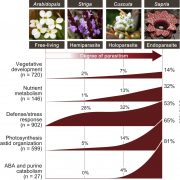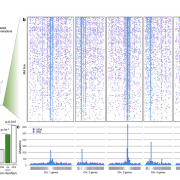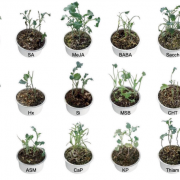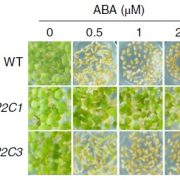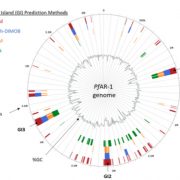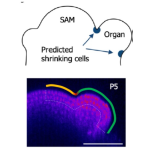LysM-mediated signaling in Marchantia polymorpha and conservation of PTI in land plants
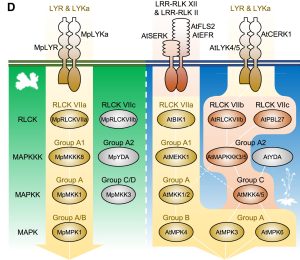 Marchantia polymorpha, the common (but adorable) liverwort, has earned its spot in the ranks of very important plant model systems, joining Physcomitrium patens as representatives of the bryophyte clade. Many systems first characterized in Arabidopsis and other angiosperms are now being studied in these plants, providing much-needed insights into their evolutionary origins and trajectories. Here, Yotsui and colleagues show evidence for functional LysM (Lysin-motif) receptors in M. polymorpha. LysM receptors recognize peptidoglycans and chitins, cell wall components of bacteria and fungi, and can recognize both pathogens and symbiotic organisms. Previous studies showed that M. polymorpha recognized bacterial and fungal cell wall extracts; this new work demonstrates that it does this through LysM receptors. Furthermore, disruption mutants of some LysM-encoding genes showed decreased responses to chitin and peptidoglycans. The authors also identified signaling components downstream of LysM through phosphoproteomic approaches. Interestingly, the found that the blue-light receptor phototropin appears to be a negative regulator of LysM-mediated defenses. (Summary by Mary Williams @PlantTeaching) Curr. Biol. 10.1016/j.cub.2023.07.068
Marchantia polymorpha, the common (but adorable) liverwort, has earned its spot in the ranks of very important plant model systems, joining Physcomitrium patens as representatives of the bryophyte clade. Many systems first characterized in Arabidopsis and other angiosperms are now being studied in these plants, providing much-needed insights into their evolutionary origins and trajectories. Here, Yotsui and colleagues show evidence for functional LysM (Lysin-motif) receptors in M. polymorpha. LysM receptors recognize peptidoglycans and chitins, cell wall components of bacteria and fungi, and can recognize both pathogens and symbiotic organisms. Previous studies showed that M. polymorpha recognized bacterial and fungal cell wall extracts; this new work demonstrates that it does this through LysM receptors. Furthermore, disruption mutants of some LysM-encoding genes showed decreased responses to chitin and peptidoglycans. The authors also identified signaling components downstream of LysM through phosphoproteomic approaches. Interestingly, the found that the blue-light receptor phototropin appears to be a negative regulator of LysM-mediated defenses. (Summary by Mary Williams @PlantTeaching) Curr. Biol. 10.1016/j.cub.2023.07.068


